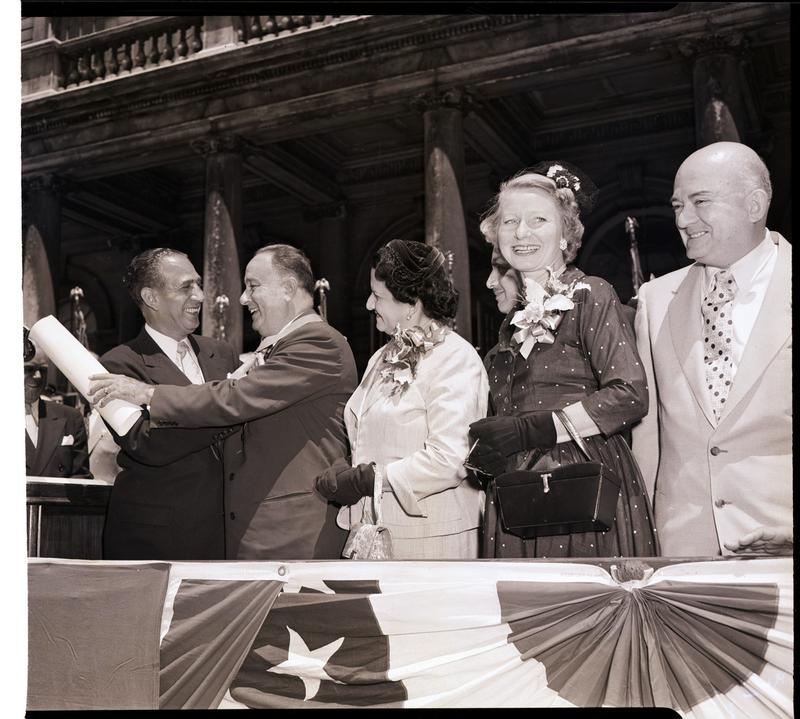Foreign Policy in Central America: Anastasio Somoza is Welcomed by Mayor Impellitteri

At this official 1952 ceremony on the steps of City Hall, the president of Nicaragua, Anastasio Somoza, is welcomed to New York by Mayor Vincent R. Impellitteri.
"Somoza may be a son of a bitch, but he's our son of a bitch." This well-known statement, supposedly uttered by Franklin D. Roosevelt, is now considered apocryphal, but sums up the attitude of successive U.S. administrations toward the Somoza family and other Central American dictators during the latter half of the 20th century. In return for a brutal repression of any Communist or Socialist movements, unelected "strongmen" were given free rein and ample U.S. support.
After formally greeting Somoza, Impellitteri notes that "his likes and dislikes parallel ours." The chief of these "likes" would seem to be baseball. He lauds Somoza for building a 50,000-seat baseball stadium as well as, earlier that day, rooting the (then New York) Giants to victory. The dislike we share is expressed in his "beating back Communist aggression and oppression." He then presents the president with a scroll for distinguished public service, and the city's medal of honor. There is a brief pause in the ceremony during which the announcer encourages people to get out of the house and enjoy this beautiful spring day. Indeed, he confides that earlier in the festivities the Police Glee Club performed a rousing rendition of "June Is Bustin' Out All Over." Somoza then thanks the mayor and other public officials. He stresses his strong ties with the United States. Both of his sons have gone to school here. One graduated with a degree in engineering, the other from West Point. He compliments Impellitteri on keeping the streets clean and on "your marvelous police force," members of which he tellingly refers to as "soldiers." With the United States' help in aiding Nicaragua's fight against Communism, "Democracy and freedom will live forever!" The Police Glee Club then sings "Sound Off!," followed by the Sanitation Band performing selections from "Kiss Me, Kate," before the Fire Department Band plays recessional music as the participants file off the platform.
Somoza was born in 1896. The son of a coffee grower, he was sent as a teenager to live with relatives in Philadelphia, where he studied business and learned English. Here, he met his future wife, who was a member of one of the wealthiest and most connected families in Nicaragua. Upon his return, he quickly immersed himself in politics. As the Latin American Studies specialist Christopher Minster, writing for the website about.com, reports:
Somoza had gotten involved in the presidential campaign of Juan Batista Sacasa, his wife’s uncle. Sacasa had been vice president under a previous administration, which had been overthrown in 1925, but in 1926 he returned to press his claim as legitimate president. As the different factions fought, the United States was forced to step in and negotiate a settlement. Somoza, with his perfect English and insider’s position in the fracas, proved invaluable to the Americans. When Sacasa finally reached the presidency in 1933, the American ambassador persuaded him to name Somoza head of the National Guard.
Somoza quickly transformed the National Guard into his own personal power base. His chief rival soon emerged as Gen. Augusto Sandino, who successfully forced out a U.S. Marine occupying force in 1933. Somoza betrayed Sandino, who had been promised safe passage to take part in peace negotiations, and had him summarily shot and buried in an unmarked grave. After this, as the history website Spartacus Educational recounts:
…Somoza and his National Guard forced President Juan Bautista Sacasa to resign in 1937. Somoza established a military dictatorship and forced his opponents into exile. His power [came] from three main sources: the ownership or control of large portions of the Nicaraguan economy, the military support of the National Guard, and his acceptance and support from the United States.
The last of these proved crucial as the specter of a Communist Central and South America was enough incentive for the State Department to provide millions of dollars of aid to Nicaragua and other dictatorships in the region while turning a blind eye toward human rights abuses. As the website Volunteer Nicaragua reports:
From the beginning of his rule, Anastasio Somoza was an unapologetic sycophant as far as Nicaragua’s relationship with the United States was concerned. According to historian Aynn Setright, Somoza ruled with what he openly professed as his “3 Ps” policy: plata (silver), plomo (lead), and palo (stick): money for his supporters (silver), bullets for his enemies (lead), and a stick for the undecided -- a threat that they must be loyal. Florence Babb succinctly describes the Somoza regime: “Corrupt and prone to using force, the Somozas and the National Guard grew wealthy and powerful at the country’s expense and were widely feared and hated.”
Despite the lip service paid to "democracy" in this speech, Somoza was the unquestioned ruler of Nicaragua from 1937 until his assassination in 1956. (When not in office himself, he operated behind the scenes, using figureheads.) Upon Somoza's death, his son Luis ruled, until dying of a heart attack in 1967, followed by Luis's younger brother, also named Anastasio (the West Point graduate), who fell from power in 1979 and was assassinated shortly thereafter.
Audio courtesy of the NYC Municipal Archives WNYC Collection.
